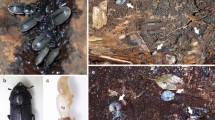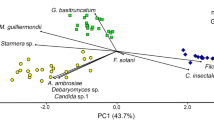Abstract
Female stag beetles (Lucanidae) possess internal mycangia to maintain microbial cultures. Yeasts from these mycangia may help with larval nutrition in nutrient poor woody substrates, but only a few Lucanidae taxa have been studied and all reports originate from Europe and Asia. We identify the first mycangial yeasts of a South African endemic Lucanidae beetle, Xiphodontus antilope, using nuclear ribosomal RNA and ITS DNA sequence data. In addition we identified yeasts from the larval gut, fecal matter, frass and woody substrate surrounding larvae and pupae. The mycangium of X. antilope was confined to females and is structurally similar to all other Lucanidae. Unlike most Lucanidae that seemingly associate with single species of yeast, or whose mycangia contain yeast monocultures, three yeast species were commonly isolated from X. antilope. Scheffersomyces coipomoensis was the most numerically dominant species on most substrates and in most individuals, but a second, undescribed, Scheffersomyces species was present in high numbers. A third species, also undescribed and unrelated to Scheffersomyces, was recovered from all mycangia but could not be detected in the larval gut, fecal matter, frass or woody substrates. We confirm a close association of Scheffersomyces yeasts with Lucanidae globally, but other taxa may also be involved. We show that the predominant mycangial yeasts also form the predominant yeasts within the larval gut and the woody substrates around the larvae and pupae. This combined external and internal colonization by the same yeasts may provide enhanced opportunities for nutrient acquisition, but this needs validation in future studies.


Similar content being viewed by others
References
Altschul SF, Madden TL, Schaffer AA, Zhang J, Zhang Z, Miller W, Lipman DJ (1997) Gapped BLAST and PSI-BLAST: a new generation of protein database search programs. Nucl Acids Res 25:3389–3402
Araya K (2006) Effort on feeding tree trunks: a case of decaying wood and lucanid larvae. In: Shibata E, Togashi K (eds) The fascinating lives of insects residing in tree trunks: an introduction to tree-boring insects. Tokai University Press, Kanagawa, pp 213–236
Bartolozzi L (2005) Description of two new stag beetle species from South Africa (Coleoptera: Lucanidae). Afr Entomol 13:347–352
Bartolozzi L, Werner K (2004) Illustrated catalogue of the Lucanidae from Africa and Madagascar. Taita Publishers, Czech Republic
Bartolozzi L, Perissinotto R, Clennell L (2019) Description of the female of Xiphodontus endroedyi Bartolozzi, 2005 (Coleoptera: Lucanidae). Fragm Entomol 51:187–188
Beaver RA (1989) Insect-fungus relationship in the bark and ambrosia beetles. In: Wilding N, Collins NM, Hammond PM, Webber JF (eds) Insect-fungus interactions. Academic Press, London, pp 121–143
Breznak JA, Brune A (1994) Role of microorganisms in the digestion of lignocellulose by termites. Annu Rev Entomol 39:453–487
Dussán KJ, Justo OR, Perez VH, David GD, Junior Silveira EG, da Silva SS (2019) Bioethanol production from sugarcane bagasse hemicellulose hydrolysate by immobilized S. shehatae in a fluidized bed fermenter under magnetic field. Bioenergy Res 12:338–346
Francke-Grosmann H (1967) Ectosymbiosis in wood-inhabiting insects. In: Henry SM (ed) symbiosis. Academic Press, New York, pp 142–206
Fremlin M, Tanahashi M (2015) Sexually-dimorphic post-eclosion behavior in the European stag beetle Lucanus cervus (L.) (Coleoptera: Lucanidae). Bull Soc Entomol Suisse 8:29–38
Geib SM, Filley TR, Hatcher PG, Hoover K, Carlson JE, Jimenez-Gasco MM, Nakagawa-Izumi A, Sleighter RL, Tien M (2009) Lignin degradation in wood-feeding insects. Proc Nat Acad Sci USA 105:12932–12937
Grebennikov VV, Leschen RA (2010) External exoskeletal cavities in Coleoptera and their possible mycangial functions. Entomol Sci 13:81–98
Haack RA, Slansky F (1987) Nutritional ecology of wood feeding Coleoptera, Lepidoptera, and Hymenoptera. In: Slansky F, Rodriguez JG (eds) Nutritional ecology of insects, mites, and spiders. Wiley, New York, pp 449–486
Hall TA (1999) BioEdit: a user-friendly biological sequence alignment editor and analysis program for Windows 95/98/NT. Nucl Acids Symp Ser 41:95–98
Hawes CJ (2013) Discovery of a mycangium and associated yeasts in the stag beetle Lucanus cervus (Coleoptera: Lucanidae). White Admiral 85:22–23
Kamata N (2014) Insect harms and plant defenses. In: Society Tree Health Research (ed) An introduction to tree health science. Kaiseisha Press, Otsu, pp 237–260
Kim S, Farrell B (2015) Phylogeny of world stag beetles (Coleoptera: Lucanidae) reveals a Gondwanan origin of Darwin’s stag beetle. Mol Phylogenet Evol 86:35–48
Kostovcik M, Bateman CC, Kolarik M, Stelinski LL, Jordal BH, Hulcr J (2015) The ambrosia symbiosis is specific in some species and promiscuous in others: evidence from community pyrosequencing. ISME J 9:126–130
Kuranouchi T, Nakamura T, Shimamura S, Kojima H, Goka K, Okabe K, Mochizuki A (2006) Nitrogen fixation in the stag beetle, Dorcus (Macrodorcus) rectus (Motschulsky) (Col., Lucanidae). J Appl Entomol 130:471–472
Liu K-F, Li X-H, Hui FL (2018) Yarrowia brassicae f.a., sp. nov., a new yeast species from traditional Chinese sauerkraut. Int J Syst Evol Microbiol 68:2024–2027
Miller MA, Pfeiffer W, Schwartz T (2010) Creating the CIPRES sciences gateway for inference of large phylogenetic trees. In: Miller MA, Pfeiffer W, Schwartz T (eds) Proceedings of the gateway computing environments workshop (GCE). New Orleans, USA, pp 1–8
Miyashita A, Hirai Y, Sekimizu K, Kaito C (2015) Antibiotic-producing bacteria from stag beetle mycangia. Drug Discov Ther 9:33–37
Möller EM, Bahnweg G, Sandermann H, Geiger HH (1992) A simple and efficient protocol for isolation of high molecular weight DNA from filamentous fungi, fruit bodies, and infected plant tissues. Nucl Acids Res 22:6115–6116
Pattengale ND, Alipour M, Bininda-Emonds ORP, Moret BME, Stamatakis A (2010) How many bootstrap replicates are necessary? J Comput Biol 17:337–354
Rani A, Sharma A, Rajagopal R, Adak T, Bhatnagar RK (2009) Bacterial diversity analysis of larvae and adult midgut microflora using culture-dependent and culture-independent methods in lab-reared and field-collected Anopheles stephensi—an Asian malarial vector. BMC Microbiol 9:96
Ronquist F, Teslenko M, Van Der Mark P, Ayres DL, Darling A, Höhna S, Larget B, Liu L, Suchard MA, Huelsenbeck JP (2012) Mrbayes 3.2: efficient bayesian phylogenetic inference and model choice across a large model space. Syst Biol 61:539–542
Six DL (2003) Bark beetle-fungal symbiosis. In: Bourtzis K, Miller T (eds) Insect symbiosis. CRC Press, Boca Raton, pp 97–114
Stamatakis A (2014) RAxML version 8: a tool for phylogenetic analysis and post-analysis of large phylogenies. Bioinformatics 30:1312–1313
Suh SO, Marshall CJ, McHugh JV, Blackwell M (2003) Wood ingestion by passalid beetles in the presence of xylose fermenting gut yeasts. Mol Ecol 12:3137–3145
Tanahashi M, Hawes CJ (2016) The presence of a mycangium in the horned stag beetle Sinodendron cylindricum (Coleoptera: Lucanidae) and the associated yeast symbionts. J Insect Sci 16:76
Tanahashi M, Kubota K (2013) Utilization of the nutrients in the soluble and insoluble fractions of fungal mycelium by larvae of the stag beetle, Dorcus rectus (Coleoptera: Lucanidae). Eur J Entomol 110:611–615
Tanahashi M, Matsushita N, Togashi K (2009) Are stag beetles fungivorous? J Insect Physiol 55:983–988
Tanahashi M, Kubota K, Matsushita N, Togashi K (2010) Discovery of mycangia and associated xylose-fermenting yeasts in stag beetles (Coleoptera: Lucanidae). Naturwissenschaften 97:311–317
Tanahashi M, Kim J-K, Watanabe K, Fukatsu T, Kubota K (2017) Specificity and genetic diversity of xylose-fermenting Scheffersomyces yeasts associated with small blue stag beetles of the genus Platycerus in East Asia. Mycologia 109:630–642
Tanahashi M, Ikeda H, Kubota K (2018) Elementary budget of stag beetle larvae associated with selective utilization of nitrogen in decaying wood. Sci Nat 105:33
Toki W, Tanahashi M, Togashi K, Fukatsu T (2012) Fungal farming in a non-social beetle. PLoS ONE 7:e41893
Urbina H, Blackwell M (2012) Multilocus phylogenetic study of the Scheffersomyces yeast clade and characterization of the N-terminal region of xylose reductase gene. PLoS ONE 7:e39128
Urbina H, Frank R, Blackwell M (2013) Scheffersomyces cryptocercus: a new xylose-fermenting yeast associated with the gut of wood roaches and new combinations in the Sugiyamaella yeast clade. Mycologia 105:650–660
White TJ, Bruns SL, Taylor J (1990) Amplification and direct sequencing of fungal ribosomal RNA genes for phylogenetics. In: Innis MA, Gelfand DH, Sninsky JJ, White TJ (eds) PCR protocols—a guide to methods and applications. Academic Press, New York, pp 315–322
Author information
Authors and Affiliations
Contributions
All authors contributed to the study conception and design. Material preparation and data collection was performed by Francois Roets and analysis was performed by Kenneth Oberlander. The first draft of the manuscript was written by Francois Roets and all authors commented on previous versions of the manuscript. All authors read and approved the final manuscript.
Corresponding author
Ethics declarations
Conflict of interest
The authors declare that they have no conflict of interest.
Ethical approval
No ethical approval required, but animals were euthanized using methods that cause minimum discomfort.
Additional information
Publisher's Note
Springer Nature remains neutral with regard to jurisdictional claims in published maps and institutional affiliations.
Rights and permissions
About this article
Cite this article
Roets, F., Oberlander, K.C. Symbiotic yeasts from the mycangium, larval gut and woody substrate of an African stag beetle Xiphodontus antilope (Coleoptera: Lucanidae). Antonie van Leeuwenhoek 113, 1123–1134 (2020). https://doi.org/10.1007/s10482-020-01418-1
Received:
Accepted:
Published:
Issue Date:
DOI: https://doi.org/10.1007/s10482-020-01418-1




